Secure, effective digital services require a consistent approach to identity across the organisation. However, owing to the proliferation of platforms and applications, most organisations need to manage their identity data using different systems, information, and formats.
This makes it hard to manage identities consistently. Consequently, a critical capability of any Identity and Access Management (IAM) system is the ability to construct identities from multiple sources of data.
The Strategic Challenge of Fragmented Identity Data
People enter and interact with organisations in different ways, and their data does the same. Consequently, organisations will always have multiple sources of people data: CRM systems, HR databases, marketing platforms, and various applications.
While organisations should keep these to a minimum, it is inevitable a way of managing this data coherently is needed. That’s because fragmented data creates two strategic problems for organisations:
- Financial costs. Data that is fragmented across many systems must be centralised to maximise its usefulness. This can be costly, particularly if it is labour intensive. Automation can help, but that needs developing and maintaining.
- Opportunity costs. Of course, the business can choose to live without centralisation, but that creates opportunity costs: the business is deprived of useful possibilities because the data is uncertain or unavailable.
- Risks. Fragmented data leads to duplication and manual data entry errors. Duplicate accounts, conflicting permissions, and disjointed records not only disrupt workflows but can also introduce security vulnerabilities by leaving old or inaccurate permissions in place.
Making the Business Case for Unified Identities
It is easy to lose focus on the quality of data when other issues are more visible. However, data underpins all business architecture and, as the saying goes, garbage in, garbage out. Delay is simply storing up problems for the future. And the longer an organisation delays, the harder and more costly it becomes to eventually unpick.
Creating unified identities from multiple sources of people data provides several important benefits:
- Improved User Experience: By consolidating identity data, organisations can offer a seamless, single sign-on (SSO) experience, reducing the friction of remembering multiple credentials and enhancing user satisfaction.
- Enhanced Security and Compliance: A unified approach enables organisations to apply consistent security policies across all applications, helping to prevent unauthorised access and reducing the risk of data breaches. This centralisation also aids in compliance efforts by enabling comprehensive reporting and monitoring of access-related activities.
- Operational Efficiency: With identity data consolidated into a single system, IT teams can more efficiently manage user access requests, handle onboarding and offboarding, and streamline workflows related to identity verification and role assignments.
- Data-Driven Insights: Unified identities enable organisations to gain a holistic view of each user, facilitating data-driven insights into user behaviour, access patterns, and potential risks. These insights are invaluable for optimising identity policies, improving security measures, and aligning access controls with business objectives.
How Able+ Can Help Unify and Centralise Identity Data
Able+ is an IAM solution by New Era Technology that brings together fragmented identity data to create a single, unified source of truth. This makes it possible to enforce consistent access policies, reduce redundancy, and streamline the user experience across all applications and systems.
- Data Integration and Interoperability: Able+ integrates with multiple data sources and applications, facilitating the seamless flow of identity data across platforms. Through API integrations and data connectors, Able+ centralises data from various sources, unifying fragmented information.
- Workflows: Able+ provides workflows that can process the data collected from the various sources. Workflows are highly flexible, meaning that almost any business process can be captured. This enables the organisation to make best use of its data by maximising the opportunities for automation. Workflows are built and managed using a zero-code designer, enabling business process owners to take control of their workflows.
- Role-Based Access Control: Able+ enables organisations to define roles and access privileges centrally. This ensures that users have appropriate access based on their roles, which can be updated globally whenever there are changes. This centralised approach minimises errors and reduces the complexity associated with managing permissions across multiple systems.
- Single Sign On: Able+ support Single Sign On, allowing users to access multiple applications with a single set of credentials. Federation reduces the need for duplicate identity records and enables seamless access across domains, enhancing both security and user convenience.
Conclusion
By addressing challenges related to the fragmentation of identity data, unifying identities enables organisations to make the best of its identity data. This can enhance security, cost efficiency, and user experience. Able+ provides the tools to unify identities and so help your organisation achieve its IAM goals.

 Australia
Australia Canada
Canada LATAM
LATAM New Zealand
New Zealand UAE
UAE United States
United States








